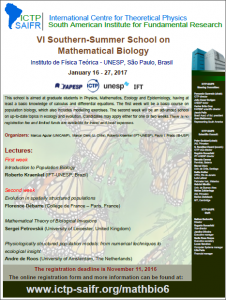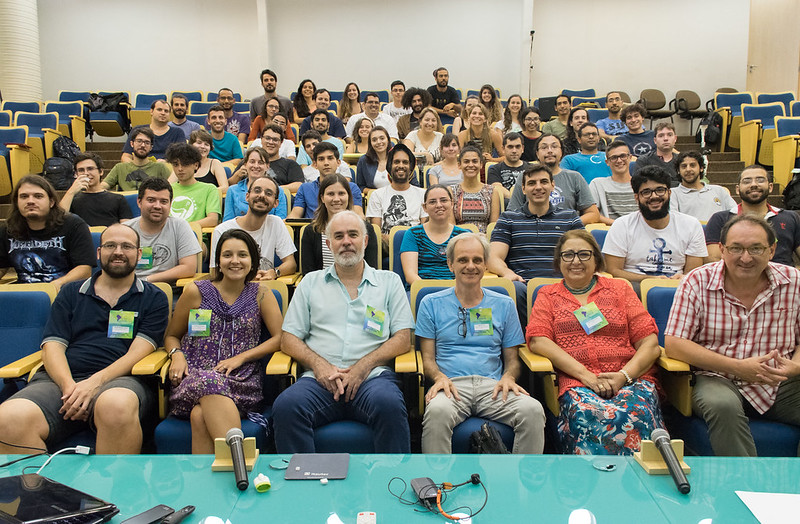VI Southern-Summer School on Mathematical Biology
January 16 – 27, 2017
São Paulo, Brazil
ICTP-SAIFR/IFT-UNESP
![]()
Home
This school is aimed at graduate students in Physics, Mathematics, Ecology and Epidemiology, having at least a basic knowledge of calculus and differential equations. The first week will be a basic course on population biology, which also includes modelling exercises. The second week will be an advanced school on up-to-date topics in ecology and evolution. Candidates may apply either for one or two weeks. Undergraduate students with exceptional records are also encouraged to apply. Limited funds are available for travel and local expenses. There is no registration fee.
Please note that acceptance cannot be taken for granted, as we expect a much higher number of applications than the maximum number of participants. We advise the candidates to carefully complete the application form, providing enough information for the selection committee to take a decision.
In order to have an idea of the kind of activities that take place during the course, please visit the home-page of the first four editions of this school at http://www.ictp-saifr.org/mathbio, http://www.ictp-saifr.org/mathbio2, http://www.ictp-saifr.org/mathbio3, http://www.ictp-saifr.org/mathbio4 and http://www.ictp-saifr.org/mathbio5.
Organizers:
- Marcus Aguiar (UNICAMP, Brazil)
- Marcel Clerc (Universidad de Chile)
- Roberto Kraenkel (IFT-UNESP, Brazil)
- Paulo Inácio Prado (USP/SP, Brazil)
Satisfaction survey:
- click here
Lecturers
First week
Introduction to Population Biology
Roberto Kraenkel (IFT-UNESP, Brazil):
1) single species dynamics
2) interacting species I: competition
3) interacting species II: predator-prey dynamics
4) models in epidemiology
5) spatial population dynamics
Second week
Evolution in spatially structured populations
Florence Débarre (Collège de France – Paris, France)
Most populations exhibit some form of spatial structure, for instance because they are subdivided, because the environment they live in is spatially heterogeneous, or also because there are limits to the distances than an individual can travel. In this series of courses, I will present different tools and methods to study evolution in spatially structured populations, and will show how to apply them to specific questions, such as the evolution of dispersal, or the evolution of social behavior.
Evolution of molecular phenotypes: from gene regulation to immune system
Armita Nourmohammad (Princeton University, USA)
Molecular phenotypes, such as gene expression or protein binding affinities are important targets of natural selection, and are often subject to time-dependent pressure form the environment. However, the map between encoding DNA sequences and molecular phenotypes is often too difficult to quantify. In these lectures, I will show that universality is an emerging property of complex phenotypes, which are encoded by multiple genomic loci. I will introduce a non-equilibrium framework for adaptive dynamics of such phenotypes in time-dependent environments, and between co-evolving populations. In time-dependent environments, changes in the environment drive the evolution of the species, but not vice versa. As an example, I will present strong evidence that adaptation dominates the evolution of gene expression levels in Drosophila. Co-evolving populations reciprocally affect the fitness of each other, acting as time-dependent environments with feedback. As an example, I will show evidence of co-adaptation between interacting cellular populations of HIV viruses and the antibody repertoire of a patient over the course of an infection. In particular, I discuss the conditions for emergence of broadly neutralizing antibodies, which are recognized as critical for designing an effective vaccine against HIV.
Mathematical Theory of Biological Invasions
Sergei Petrovskii (University of Leicester, United Kingdom)
Biological invasions – which is a generic name for the phenomena occurring after a new, “alien” species is introduced – is thought to be the second most serious threat to biodiversity worldwide. It is also a very practical problem as it causes billions of dollars of economic loss annually due to the direct damage to agriculture resulting from invasion of pests. Mathematical modelling is an efficient research tool to understand the dynamics of the alien species’ establishment and proliferation. I will consider a variety of modelling approaches and techniques that can be used to study this problem in different ecological context (e.g. homogeneous or heterogeneous environment, interspecific interactions etc.). The main focus will be on the factors that may affect the rate of spread, the spatial patterns arising in the wake of the spread, and the possibility of fighting the spread through biological control.
Physiologically structured population models: from numerical techniques to ecological insight
Andre de Roos (University of Amsterdam, The Netherlands)
Many problems in ecology and evolution revolve around the question how individual life history influences population and community dynamics or vice versa how the population and community setting influences selection and adaptation of individual life histories. Physiologically structured population models are well suited to address such questions as this class of models represents the reproduction, development and mortality of individuals during their life history as dependent on the state of the individual itself and the environment it lives in. These structured population models hence consistently translate the individual life history to the population level and in turn account for density dependent, population feedback on life history through changes in the environment that the individual experiences. In recent years, a general methodology has been developed to carry out demographic, equilibrium (bifurcation) and evolutionary analysis of physiologically structured population models, which in its simplest form boils down to the numerical evaluation of the Lotka-Euler integral equation for computing population growth rates. I will give an introduction to the general methodology and illustrate its application with a few examples.
Subsequently, I will discuss how physiologically structured population models have been used to develop novel and counterintuitive ecological theory about the population and community effects of ontogenetic development. Growth in body size is by far the most prominent aspect of the ontogenetic development that every individual goes through during its life history. Necessarily, development depends on the availability of food and thus indirectly on the feedback from population foraging. I will show that population models accounting for food-dependent growth in body size of individuals make predictions that are in line with the classical unstructured theory about population and community dynamics, only in case of ontogenetic symmetry in energetics, meaning that development and reproduction are limited to the same extent by food availability. In contrast, in case of ontogenetic asymmetry in energetics, when either development or reproduction is more food-limited than the other process, models that account for food-dependent development make different and counter-intuitive predictions, as it may, for example, result in positive relationships between population biomass and individual mortality. The body size effects on community structure are even more substantial when species have a complex life cycle and growth in body size hence leads to a change in resource use or habitat during ontogeny. I will provide an overview of possible consequences of ontogenetic development for community structure and show how they come about because the population size distribution changes with changes in the environmental conditions, like productivity or mortality.
Poster
Photos
Program
Group Wiksite:
- relevant information on group projects, lectures and tutorials. Click here
School Program: PDF version (updated on Dec. 21, 2016)
|
1st WEEK |
|||||||
| Monday, January 16 | Tuesday, January 17 | Wednesday, January 18 | Thursday, January 19 | Friday, January 20 | Saturday, January 21 | Sunday, January 22 | |
| 9:30 – 11:00 | Registration (at 9:00) | LECTURE II: Competition (video 1)(video 2) (PDF) | LECTURE III:Predation | Lecture IV: Epidemiology | Lecture V: Spatial Ecology (video1) (video2) (PDF) | Lecture VI: Bistability
and histeresys |
Group presentations (at 10:00) |
| 11:00 – 18:00 | LUNCH (at 11:30)GROUP WORK (at 13:30) | WORK ON PROJECTS (lunch and coffee breaks in between) | WORK ON PROJECTS (lunch and coffee breaks in between) | WORK ON PROJECTS (lunch and coffee breaks in between) | WORK ON PROJECTS (lunch and coffee breaks in between) | WORK ON PROJECTS (lunch and coffee breaks in between) | |
| 18:00 – 19:30 | PRESENTATIONS | Special Lecture | Bestiarium | ||||
|
2nd WEEK |
|||||||
| Monday, January 23 | Tuesday, January 24 | Wednesday, January 25 | Thursday, January 26 | Friday, January 27 | |||
| 10:30 – 12:10 | FREE | Petrovskii I | Débarre III | de Roos III | Petrovskii IV | ||
| 12:10 – 14:00 | LUNCH | ||||||
| 14:00 – 15:40 | Débarre I (video) (PDF) (at 15:00)
COFFEE BREAK (at 16:40) |
de Roos I | Petrovskii II(video) | Petrovskii III | de Roos IV | ||
| 15:40 – 16:10 | COFFEE BREAK | FREE | |||||
| 16:10 – 17:50 | Débarre II | de Roos II | Débarre IV | ||||
| 18:00 -19:30 | Nourmohammad II(video) (PDF) | ||||||
Group Presentations:
Additional Information
List of Confirmed Participants: Updated on January 6
Registration: ALL participants should register. The registration will be on January 16 at the institute from 9:00 to 10:00 am, for those who will start on the first week. And from 1:00 to 2:00pm on January 23, for those who will start on the second week. You can find arrival instructions at http://www.ictp-saifr.org/?page_id=195
Accommodation: Participants, whose accommodation has been provided by the institute will stay at The Universe Flat. Each participant, whose accommodation has been provided by the institute, has received the accommodation details individually by email.
BOARDING PASS: All participants, whose travel has been provided or will be reimbursed by the institute, should bring the boarding pass upon registration, and collect an envelope to send the return boarding pass to the institute.
Emergency number: 9 8233 8671 (from São Paulo city); +55 11 9 8233 8671 (from abroad), 11 9 8233 8671 (from outside São Paulo).
Ground transportation instructions:
Ground transportation from Guarulhos Airport to The Universe Flat
Ground transportation from Congonhas Airport to the Universe Flat
Ground transportation from The Universe Flat to the institute

